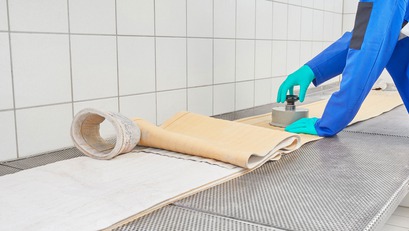Top quality through Laboratory Analysis
at BWF Envirotec
Every product is precisely tested for quality in the laboratory.
Analyses of fibres, textiles and assembled filter media are rigorously reviewed by our R&D team. With a multitude of highly specialised analysers, our R&D Competence Centre is optimally equipped for every task and challenge.
Our laboratory analyses monitor projects from the idea to the finished product. In addition to new products, both laboratories also analyse used filter media.
Our chemistry laboratory includes the following equipment:
- An FTIR spectrometer for analysing fibres and changes in chemical structure
- Extraction plants for testing fibres and fibre-adjacent fabrics
- Equipment for testing the chemical and thermal load capacities of filter media
- RFA
- Test bench for measuring catalyst activity on filter cartridges
The mechanical-technological laboratory has the following equipment:
- Devices for determining physical parameters such as air permeability, fibre fitness, maximum tensile force, electrostatic properties or pore size
- Various microscopes (reflected and transmitted light) for more accurate assessment of, for example, needle felt, fibres and needles
- A scanning electron microscope (SEM) for magnifications of up to 50,000x
Service spectrum of BWF Envirotec laboratory analysis
BWF Envirotec laboratory analysis conducts various analyses, processes and tests to ensure the quality and safety of our products.
Chemical-physical analyses by BWF Envirotec laboratory analytics
FTIR spectroscopy
- Analysis of fibre type and possible fibre damage
Wet-chemical processes
- Analysis of the chemical finish
- Determination of oil and water repellence (in line with AATCC 118-1972/3M-Test)
- Determination of the pH value (in line with DIN EN 1413)
- Dust characterisation
Mechanical-technological tests by BWF Envirotec Laboratory Analytics
- Analysis of customer samples and determination of physical product parameters
- Analysis of fibre fineness (in line with DIN EN ISO 1973)
- Analysis of the supporting fabric structure (basis weight, type of bond, fibre density, yarn structure, yarn count)
- Determination of air permeability (in line with EN ISO 9237/DIN 53887)
- Determination of basis weight (in line with ISO 9073-1)
- Determination of thickness and density
- Determination of pore size distribution
- Tensile tests (in line with ISO 9073-3) and tear propagation tests (in line with DIN 53859-2)
- Determination of electrostatic behaviour (in line with DIN 54345-1/DIN 54345-5) and thermal behaviour
- Analysis of surface finish






